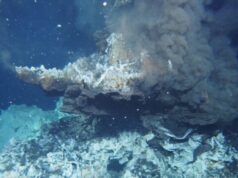Coral bleaching.Credit: ARC Centre of Excellence for Coral Reef Studies
A new study has found that Great Barrier Reef (GBR) corals were able to survive past bleaching events because they were exposed to a pattern of gradually warming waters in the lead up to each episode. However, this protective pattern is likely to be lost under near future climate change scenarios.
In a paper published in Science today, researchers from ARC Centre of Excellence for Coral Reef Studies (Coral CoE) at James Cook University (JCU) and the University of Queensland (UQ), as well as the U.S. National Oceanic and Atmospheric Administration (NOAA) investigated what this warming pattern means for GBR coral bleaching events into the future.
Lead author Dr. Tracy Ainsworth from Coral CoE explains that bleaching is like a marathon for corals: “When corals are exposed to a pre-stress period in the weeks before bleaching, as temperatures start to climb, this acts like a practice run and prepares the coral. Corals that are exposed to this pattern are then less stressed and more tolerant when bleaching does occur.”
The researchers found that this “practice run” induces heat shock responses in the coral that reduce their severity of bleaching and mortality. The protective “practice run” was observed in three-quarters of stress events that occurred on the GBR in the past three decades.
Find your dream job in the space industry. Check our Space Job Board »
Early evidence suggests that the 2016 GBR bleaching event has also followed the same pattern. Some individual reefs not previously exposed to bleaching stress at all missed out on the “practice run” this time, suggesting that the damage to the corals on those reefs could be even greater.
The pre-stress conditions are expected to disappear when seawater temperatures rise by as little as 0.5 °C, such as predicted for the near future. Corals will then instead be directly exposed to stress events.
“When corals lose the practice run, there is no break, or “relaxing” for the corals as summer stress develops,” explains co-author Dr. Scott Heron, from Coral Reef Watch at NOAA. “In future summers, bleaching events will occur more often and, without the practice run, become even more severe–with a greater risk for coral mortality and a fast decline in coral cover across reefs.”
The study examined 27 years worth of satellite data for sea surface temperatures, previous coral bleaching events, and studied how corals responded to different seawater warming conditions. Under future climate change predictions, different reefs on the GBR will lose their protective mechanism at different rates. The study recommends that reefs able to retain the “practice run” of protective conditions prior to bleaching be given high priority for conservation efforts.
“Our models suggest reefs that lose their thermal protection in the future will degrade faster and stay in a degraded state for a longer period, while reefs that maintain their protection have a better chance of maintaining coral cover–if carbon emissions are reduced in the near future,” says Dr. Juan Ortiz from UQ.
Associate Professor Bill Leggat, from Coral CoE adds, “Knowing which temperature patterns are present on different reefs, how these impact coral survival and their capacity to recover from bleaching, and how quickly changes in these patterns occur, will inform reef management. This knowledge will help managers increase the likelihood of coral surviving bleaching events in the future by reducing the impact of other stressors, such as pollution and over-use, at both local and regional scales.” Professor Peter Mumby, also from Coral CoE concludes, “Our results underscore, once again, the importance of global action to reduce greenhouse gas emissions. We can still have a beautiful reef if people are willing to change behaviour.”
This article originally appeared at ARC Centre of Excellence in Coral Reef Studies.
Journal Reference:
- Ainsworth et al. Climate change disables coral bleaching protection on the Great Barrier Reef. Science, 15 April, 2016 DOI:10.1126/science.aac7125











